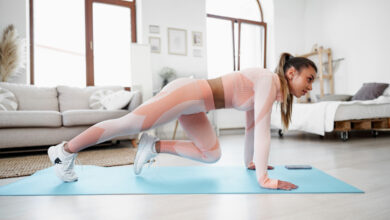5 Overrated Exercises, According to Trainers

We asked three trainers to dish on the most overrated exercises they see people doing, and what they’d suggest you do instead to get closer to your fitness goals. It’s not that these are necessarily bad exercises, but they’ve maybe gotten a bit more attention than they deserve, or there are safer or more effective alternatives you can do instead. Here are five that you may want to reassess the next time you hit the gym.
Experts In This Article
- Dee King, CPT, trainer
- Derek Haywood, CPT, trainer and Orangetheory coach
- JoEllyn Poff, CNC, CPT, FNS , fitness, nutrition, and wellness coach
The treadmill
Trainer Dee King, CPT, shares that it’s not actually an exercise, per se, but a piece of equipment that pops up first on her list of overrated gym activities: the treadmill. “This may be an unpopular opinion, but hear me out” she says. “Don’t get me wrong, there are definitely some great benefits to training on a treadmill, but I don’t think it’s the be-all, end-all when it comes to cardio fitness.”
She points out that women especially have been fed the myth that the key to getting fit is to spend hours on a treadmill. “That simply isn’t the case,” she says “Besides the fact that it can get boring (don’t tell anyone I said that), if it’s something you’re not looking forward to, it becomes harder to stick with and make it part of your routine.”
To be clear, if you’re someone who actually enjoys the treadmill, hop on to your heart’s content. But don’t force yourself to use it just because you think it’s going to give you better results than other cardio options. Some alternatives King suggests to treadmill work that will increase the heart rate just as much are speed squats, ground to overhead press, jumping rope, rowing, or even dancing.
Push-ups
Push-ups are a tried and true exercise that almost all of us have been familiar with since middle school gym class. But trainer and Orangetheory coach Derek Haywood, CPT, says that, although push-ups are a good way to work your chest, shoulders, and arms, he recommends spicing them up a bit. “A way to ramp up your push-ups is to do walkout push-ups, which also activates our core,” he says.
What does that look like? “Instead of starting in a push-up position, you start standing. Hinge in the hips and place your hands on the ground (as close as you can get to your feet) then begin to walk out slowly one hand at a time. Once you get to a plank position, perform your push-up and walk your hands back up to return to standing position.”
Without equipment, bodyweight exercises like push-ups can be a fantastic tool in our workouts. But because we can’t just pick up a heavier weight like we would with dumbbells, we need to add extra challenges once our body gets used to a particular move in order to keep progressing.
And if you’re still working to master the push-up itself, keep plugging away, but know that adding a walkout will give you more bang for your buck by bringing in some extra core burn.
Barbell bench press
Trainer and wellness coach JoEllyn Poff, CNC, CPT, FNS, says that because of the fixed position of a barbell bench press, this exercise can contribute to shoulder pain and injuries and even create strength imbalances in the arms. As an alternative, she suggests using dumbbells for your bench presses instead. “When you do this,” says Poff, “it allows both arms to work independently and the shoulders to have better placement.”
Overall, dumbbells are a great alternate option for most barbell exercises, since they allow versatility for unilateral training and can help to increase your range of motion. Especially if you struggle with mobility, you might want to consider dumbbells to do some of your favorite barbell exercises.
Forward lunge
Lunges are one of those exercises many people have a love/hate relationship with, so you may be happy to hear that King finds them to be overrated. However, don’t get too excited, because this only refers to the forward or walking lunge. “Instead,” she says, “I prefer a reverse lunge or a Bulgarian split squat.”
Her reason for this is simple: “The reverse lunge and Bulgarian split squat allow you to keep your knees in a safer and more stable position, which gives you the opportunity to focus more on your quads, glutes, and hamstrings, which are the areas targeted by lunges in the first place,” she says.
Crunches and sit-ups
Many trainers will tell you that both crunches and sit-ups aren’t the ideal way to work your core.
“I find it unnecessary to spend a plethora of time dedicated to crunches when the same work can be incorporated into the rest of your workout,” says King. “Work smarter, not harder.” Doing crunches improperly can also lead to injury if you mistakenly pull on your head or neck instead of lifting with your chest.
King says she prefers a plank, hollow rock, or simply actively engaging your core regardless of what movement you’re doing. This means using your core while doing squats, biceps curls, deadlifts, you name it! “Think about preparing to be punched in the stomach, then keep those muscles tight through all of the reps you’re working on,” she says.
Another option is the kettlebell march. Haywood says this is one of his go-to exercises when training his clients because it focuses on loading the core. To do it, stand up straight with a kettlebell in your hands. Brace your core and lift one knee to hip height, getting your thigh parallel to the ground. Haywood recommends 20 slow marches on each side. He notes that for the best results, the weight “has to be heavy enough that it forces you to want to bend over to the side which then activates your core as you fight to stay upright as you march in place,” he says.
“When done correctly, this is one of the most challenging core exercises you will find,” he says. No boring monotonous crunches required.



